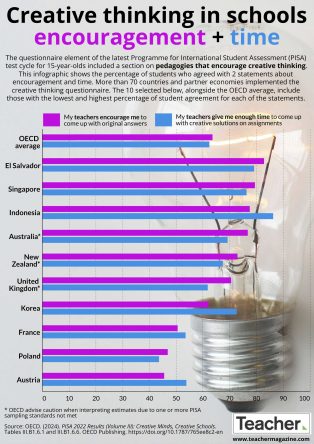International results from the first ever PISA assessment on creative thinking revealed Australia’s 15-year-olds were among the world’s top performers. Now, new analysis offers insights into student performance and attitudes, and how teachers in different states and territories are fostering creative thinking in the classroom.
The Australian Council for Educational Research (ACER) report, released today, draws on data from more than 13,430 Australian students, and principals and teachers who took part in the latest cycle of the Programme for International Student Assessment (commonly known by educators as PISA).
ACER manages the OECD assessment in Australia. Its national report on creative thinking (De Bortoli & Underwood, 2024) offers fresh insights, including a breakdown of results by geographic location, demographic groups and school sectors.
‘The OECD’s report in June named Singapore, Korea, Australia, Canada, Finland and New Zealand as the most successful education systems in developing students’ capacity to engage in creative thinking,’ lead author of ACER’s report Lisa De Bortoli says.
‘Our findings provide insight into how imaginative, adventurous, confident and capable Australia’s 15-year-olds are in their creative thinking and how it is being fostered in classrooms across the country.
‘This is critical information because creative thinking skills are fundamental to helping people develop innovative and effective responses to issues and problems – in their personal and professional lives, within communities, and as global citizens.’
Creative thinking performance levels
Thinking creatively was defined by PISA 2022 as ‘the competence to engage productively in the generation, evaluation and improvement of ideas that can result in original and effective solutions, advances in knowledge and impactful expressions of imagination,’ (De Bortoli & Underwood, 2024).
There are 7 proficiency levels on the PISA 2022 creative thinking scale: Levels 1-6 and a seventh for those students working below Level 1. Students who score 41 points or more (Level 5 or 6) are considered high performers. The baseline level of proficiency was defined as Level 3 – to achieve this National Proficient Standard, students need to score 23 points or more.
Students from 64 OECD countries and partner economies participated in the creative thinking assessment. At a national level, Australia’s students achieved a mean score of 37 points out of a possible 60, meaning their performance was like that of Canada and Korea (both 38), with only Singapore achieving a higher average (41).
The new analysis reveals the proportion of Australian students meeting the National Proficient Standard (88%) was 10 percentage points higher than the OECD average; 43% were high performers, (significantly higher than the OECD average of 27%); and 12% were low performers (compared to the OECD average of 22%).
How students across Australia performed
By state and territory
- The proportion of students who achieved the National Proficient Standard ranged from 85% in the Northern Territory to 91% in the Australian Capital Territory.
- The proportion students who were high performers ranged from 34% in Tasmania to 49% in the Australian Capital Territory.
- The proportion of students who were low performers ranged from 15% in the Northern Territory to 9% in the Australian Capital Territory.
- Students in the Australian Capital Territory performed at a similar level to students in Western Australia and at a higher level than students in all other jurisdictions.
- Students in Western Australia performed higher than students in South Australia and Tasmania.
- Students in Victoria and New South Wales performed higher than students in Tasmania.
By gender
- Almost all Australian female students (91%) attained the National Proficient Standard, compared to 85% of Australian male students.
- There was a 9 percentage point difference between female and male high-performing students, in favour of females (47% and 38%).
- There was a 6 percentage point difference between Australian female and male low-performing students, in favour of females (9% and 15%).
Student views on their own abilities
The PISA 2022 assessment also measured students’ beliefs and attitudes in relation to creative thinking. They were asked to rate their level of confidence (not at all confident; not very confident; confident; very confident) in their own creative abilities to complete a range of creative thinking tasks.
- A higher proportion of students in Australia reported they felt confident or very confident coming up with creative ideas for school projects, being creative, thinking of many new ideas for solving disagreements with people and coming up with good ideas for helping people in need than students across the OECD countries.
- A similar proportion of students in Australia and students across the OECD countries reported they felt confident or very confident telling creative stories, expressing your ideas creatively, making creative drawings, thinking of many good ideas for science experiments, and addressing social problems like pollution.
Teacher values and use of creative pedagogies
The ACER report also takes a closer look at teachers’ own values, their use of creative pedagogies, and their openness to creative pedagogies. ‘Creative teachers encourage students to express themselves freely, think differently and take risks in their learning process,’ it notes.
‘They create a supportive and stimulating learning environment that nurtures imagination and originality. This atmosphere not only enhances students’ creativity, but also boosts their confidence and motivation to learn.’
As part of PISA 2022, teachers were asked to rate their agreement (strongly disagree; disagree; agree; strongly agree) with statements about their values and beliefs about the importance of developing student creativity.
- Higher proportions of teachers in all jurisdictions agreed I value students who have many new ideas than teachers on average across the OECD countries.
- Similar proportions of teachers in New South Wales, the Northern Territory, Tasmania, South Australia, Victoria and the Australian Capital Territory agreed I value students who are capable of writing creative stories or poems than teachers on average across the OECD countries.
- Lower proportions of teachers in all jurisdictions agreed it is important that students are able to make creative works like drawing and painting and it is important for students to be able to invent new things than teachers on average across the OECD.
- Lower proportions of teachers in all jurisdictions except the Northern Territory and the Australian Capital Territory agreed it is important for students to solve science problems creatively than teachers on average across the OECD.
They were also given a list of 6 creative pedagogies and asked to rate the importance they placed (no importance, very little importance, some importance, a lot of importance) on using them in the classroom.
- A higher proportion of teachers in all jurisdictions placed importance on finding ideas through brainstorming than teachers on average across the OECD countries.
- Higher proportions of teachers in all jurisdictions except Tasmania and the Northern Territory placed importance on playing educational games than teachers on average across the OECD countries.
- Similar proportions of teachers in all jurisdictions except Queensland placed importance on group work than teachers on average across the OECD countries.
- Similar proportions of teachers in South Australia placed importance on journaling than teachers on average across the OECD countries, while in all other jurisdictions lower proportions of teachers placed importance on journaling than teachers on average across the OECD average.
- A similar proportion of teachers in the Northern Territory placed importance on debating ideas or current issues than teachers on average across the OECD countries.
- Lower proportions of teachers in all jurisdictions except the Northern Territory placed importance on debating ideas or current issues in class than teachers on average across the OECD countries.
- Lower proportions of teachers in all jurisdictions placed importance on incorporating creative activities like drawing or poetry into projects than teachers on average across the OECD countries, and lower proportions of teachers in all jurisdictions except South Australia placed importance on journaling and giving students time to explore topics on their own.
Stay tuned: Over the last few months, Teacher has been delving into PISA 2022 data to find out how Australian students are faring, and explore how education systems around the world are working to lift student outcomes. Find out more about Singapore’s home-based learning initiative, equity lessons for the AI era, 'resilient’ education systems (Japan and Lithuania), the digital learning ‘sweet spot’, Australia’s PISA performance and student experiences and digital distractions in the classroom by clicking on the links. We’ll return to these latest ACER findings on creative thinking in the new year.
References
De Bortoli, L., & Underwood, C. (2024). PISA 2022. Assessing creative thinking for a better future. Australian Council for Educational Research. https://doi.org/10.37517/978-1-74286-754-0
OECD (2024), PISA 2022 Results (Volume III): Creative Minds, Creative Schools. PISA, OECD Publishing. https://doi.org/10.1787/765ee8c2-en.
This ACER report notes: ‘Creative teachers encourage students to express themselves freely, think differently and take risks in their learning process.’
How do you create a supportive and stimulating learning environment for your students that encourages imagination and originality?
What teaching strategies do you use to develop your students’ creative thinking skills?



